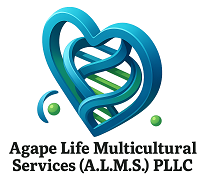Resources

Wound Care Resource Center
Trusted Education & Local Guidance for Families, Providers and Communities
Welcome to the ALMSPllc Resource Center
At Agape Life Multicultural Services (ALMSPllc), we believe that education is just as important as treatment. The more you understand chronic wounds, their risks and your care options, the better your outcomes.
This Resource Center is designed for:
-
Family caregivers managing wounds at home
-
Healthcare providers seeking collaborative care
-
Facility staff coordinating referrals and follow-up
-
Patients and loved ones seeking clarity, support and peace of mind

CAMPs vs. Hyperbaric Oxygen Therapy (HBOT): Which Works Best in Wound Care?
One of the most common questions we hear is whether patients should use Cellular and Advanced Modalities/Products (CAMPs) or Hyperbaric Oxygen Therapy (HBOT). Both have roles in wound care, but they differ greatly in accessibility, practicality and outcomes.
Cellular and Advanced Modalities/Products (CAMPs)
✅ Delivered on-site in homes, assisted living, SNFs, or rehab centers. NO travel required
✅ Application takes minutes, not hours
✅ Weekly or bi-weekly treatment visits fit seamlessly into patient routines
✅ Medicare Part B often covers approved CAMP products
✅ Effective for diabetic ulcers, venous ulcers, arterial ulcers, pressure injuries and surgical wounds
Hyperbaric Oxygen Therapy (HBOT)
⚠️ Requires travel to specialized centers equipped with oxygen chambers
⚠️ Treatments are 90 minutes per session, 5 days per week, often for 6–8 weeks
⚠️ Not practical for patients with mobility or transportation challenges
⚠️ Limited availability in rural and suburban regions
⚠️ Best results seen only in very specific wound types (e.g., ischemic diabetic ulcers, radiation injuries)
The ALMS Advantage
At ALMS (almspllc.com), we prioritize treatments that reduce stress on patients and facilities.
CAMPs fit the mobile care model, effective, efficient and delivered at the bedside.
For rare cases where HBOT is required, ALMS coordinates referrals while continuing wound management locally.
👉 Bottom Line:
-
CAMPs are practical, accessible and patient-friendly.
-
HBOT can be effective, but its travel demands and time intensity make it unrealistic for most long-term care residents and homebound patients.
What You’ll Find Here
We’ve created clear, credible and compassionate guides based on real-world experience delivering mobile wound care to patients across Texas, Louisiana, Tennessee, Arkansas, Colorado and Arizona.
Each State Resource Page includes:
-
Family Caregiver Guides
Learn what to expect, what to monitor, and when to seek mobile wound care, explained without medical jargon. -
How Mobile Wound Care Prevents Hospital Readmissions
See how ALMS reduces preventable hospital visits through timely, expert care delivered where patients live. -
Hidden Wound Care Crisis in Your State
We highlight the unseen health trends affecting seniors and chronically ill patients, with data you can share with physicians, case managers or facility administrators.
Why It Matters
Wound care is often overlooked until it's an emergency.
By using these resources, families and facilities can:
-
Prevent complications before they escalate
-
Avoid unnecessary ER visits and hospital stays
-
Improve quality of life for patients with chronic or complex wounds
-
Make faster, more informed decisions about care
-
This page also strengthens your case when speaking with:
-
Referring physicians
-
Clinical care teams
-
Investors and payers
-
Coordinators within health systems, GPOs, or ACOs


